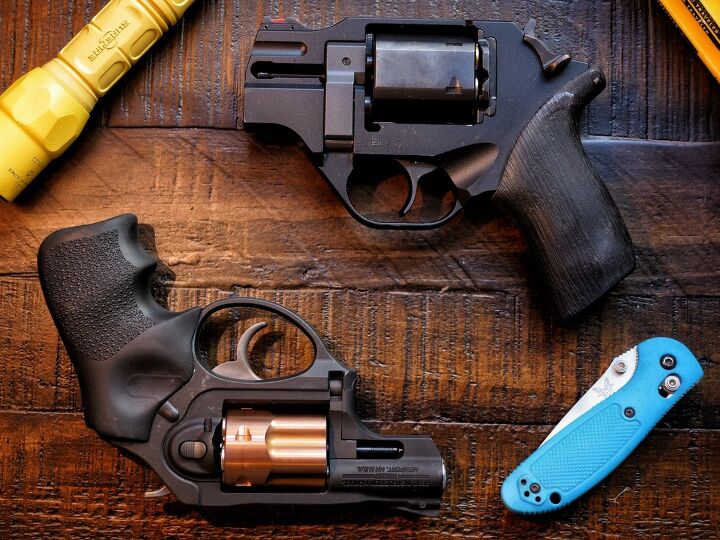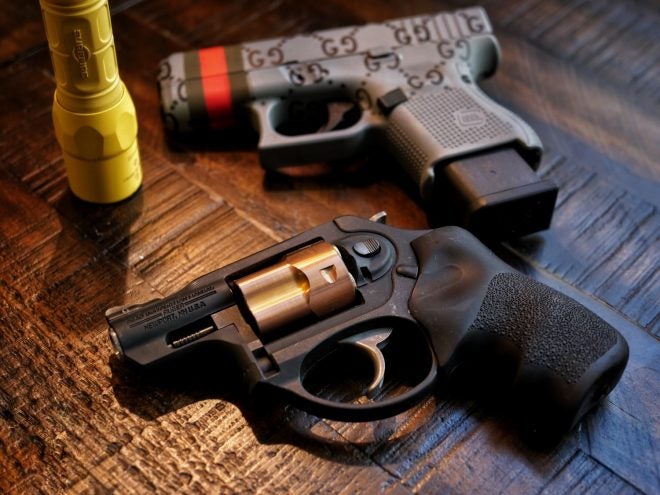Frankly, I don’t know. It doesn’t even make sense, but I find myself carrying a 5-shot Ruger LCRx revolver more often than I thought I would (my review on the LCRx is below). The best part about it is that Ruger didn’t even send me this gun – I bought it from an online gun store after a few weekend Miller Lites inspired me to purchase a blowout-priced copper cylinder model for less than $300. The next thing I know, I get a text from my FFL letting me know my pimpgun had arrived.
Concealed Carry Corner: Why I Carry a Revolver. Sometimes.
I was pretty impressed with it: Yes, while it looked like it had a natural weakness to verdigris, the revolver design itself put out a great modern vibe with an innovative feature set while maintaining classical lines. In other words, it was a damn fine looking revolver, even with the penny cylinder.

Ruger LCRx, bottom, Chiappa Rhino, top.
The LCRx checked all the boxes to make it a great carry revolver option. For one, it has a small profile, weighing only 13.5 ounces. This is accomplished by a monolithic aluminum chassis mated to a polymer fire control group housing to shed every last tenth of an ounce in weight. Ruger even dramatically fluted the cylinder to nip more chub off of the LCRx. I was pleasantly surprised with the amount of additional work Ruger put into the LCRx to ensure that it was as light as possible.
The only part of the LCRx that is subject to corrosion is the steel cylinder, which is PVD coated. PVD, or physical vapor deposition, is a durable means of coating metal parts to withstand corrosion. You’ve seen PVD on the Glock 19X, Glock’s virtually rust-proof, flat dark earth MHS contender pistol. So between the polymer/aluminum construction and the PVD cylinder, rust is a non-issue for the LCRx – and that’s a huge plus in the south.
Lightweight usually translates into a poor shooting experience, but not so with the LCRx. It has a full-spurred hammer and is thus capable of single action fire. This is a great plus as even mediocre revolvers still manage to pull off a crisp and light (I’m thinking Miller Lite again all of a sudden) trigger pull. But in most realistic defensive scenarios, one might not have the time or clarity of mind to rock that spur back, so a good double action pull is much more important than single action for a CCW wheelgat.
And the LCRx has got it in spades. According to Ruger, they use a “patented friction reducing cam […] next generation design in fire control systems that results in a smooth, non-stacking trigger pull.” I don’t know what that means, but it works. The LCRx has a great double action trigger that is relatively the same weight throughout travel. When that hammer completes its return trip, the oversized Hogue Tamer grips on the LCRx sop up the recoil well, so this is a very shootable gun.
I haven’t carried a revolver until I picked up the LCRx a couple of years ago. And I certainly don’t carry it all of the time. But I do indeed carry it. Sometimes.
Obviously, the main benefit to carrying a revolver is the reliability. While modern automatics have virtually met the revolver in terms of reliability, there’s something reassuring about the simplicity of a revolver, especially if you haven’t been keeping your autos on the maintenance program they should be on. Even if you can get 7 rounds of much more controllable and just as effective 9mm in a thinner and – for all practical purposes – as reliable Glock 43, again, it’s hard to ignore the centuries of trust that the revolver has accumulated.
Speaking of power, while the 9mm might outclass the .38 Special, strangely enough, our own Andrew recently discovered that 9mm out of a revolver actually will slightly outperform an automatic.
That runs against all the dogma you’ve heard regarding revolver bleed off and inefficiency. Maybe the modern revolver is now just as efficient as the automatic? Or, possibly, when you add the barrel length to the chamber length, perhaps there’s a longer runway with a snubby revolver versus an automatic. An auto’s barrel length measurement will typically include the chamber in the overall barrel length, completely unlike revolvers. In any event, it’s interesting to think about.
But let’s move up the power scale a little bit more. For uncompromising power, a revolver is going to be more versatile than an automatic. While you do need to scale up a frame substantially to go from a .38 to, say, a .44 Magnum, there are a lot more options for heavy power rounds in a revolver chassis versus an auto. For example, the Smith & Wesson Model 69 Combat Magnum in .44 Magnum can be up to twice as powerful as a 10mm, yet it weighs only 4 ounces more than the Glock 20 in 10mm. (Ignore for now the fact that you are getting 16 rounds of bone splitting 10 mil with the Glock versus just five for the Model 69, but I’m trying to make a case for the revolver here…) But with the revolver, you have plentiful options in terms of concealable, heavy-duty loadings, more so than with an automatic. In fact, I would venture to say that while 10mm is the pragmatic ceiling with most practical concealed carry automatics, .357 Magnum and .44 Special and Magnum options are plentiful in the wheelgun arsenal.
And if you want an unconventional perk, because the revolver doesn’t require a reciprocating mass to cycle the way an auto does, it permits the revolver to maintain a bore axis far lower than any auto. The Chiappa Rhino is a good example of this. The Chiappa Rhino is a good example of this. A bore axis in line with the shooter’s wrist reduces felt recoil from something like a .357 Magnum to feel more like a 9mm semiautomatic.

The Chiappa Rhino, pictured, fires from the bottom chamber.
Finally, the one advantage the revolver may never give up to the auto: You can quite effectively utilize a revolver from a jacket pocket:
There’s no question that the revolver’s role in everyday carry and personal protection has been severely reduced over the past century, in particular over the past 20 years as automatics with revolver-like reliability, higher-capacity, and better concealability, and greater performance have emerged and hit the market en masse. Small frame revolvers maintained a concealability edge over double stack, compact 9mm and .40 caliber automatics, until the proliferation of dependable single stack automatics in the 7 to 9 round capacity in recent years.
Even though I find myself, 9 times out of 10, carrying an auto rather than anything else, I haven’t given up on the faithful, dependable, and effective revolver just yet.
TFB’s Concealed Carry Corner is brought to you by GLOCK

 Your Privacy Choices
Your Privacy Choices
